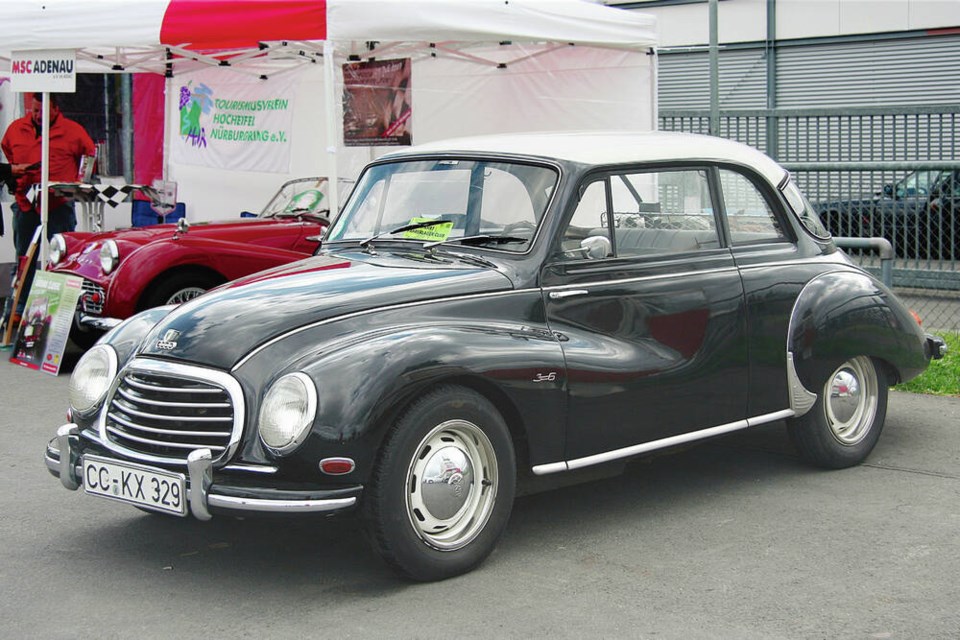Current sleek, high-tech Audis have some interesting ancestors, among them the almost forgotten DKW. Its history dated from 1904 when engineer Jorgen Rasmussen formed a company in Chemnitz, Germany, to manufacture machinery, including steam engine parts.
They experimented with complete steam engines but eventually made their reputation as manufactures of high quality, two-stroke motorcycles (DKW originally meant steam powered vehicles, later Das Kleine Wunder — the small wonder). By 1928 it was the world’s largest motorcycle manufacturer.
This led to the car business, also in 1928, and DKW would carry its two-stroke principle to the end of its automobile production. Their first model had a 584 cc two-cylinder, two-stroke engine.
DKW acquired Audi in 1928, and then in 1932 the Depression forced Audi, DKW, Wanderer and Horch to merge under the Auto Union banner. Although there was gradual integration and standardization of components, they continued building cars under their own names. The four interlocking rings on Audi’s badge symbolize these four founding companies.
In 1931, DKW’s F1 model, later called the Front, was a significant automotive pioneer. It was the first production car to combine front-wheel drive, a transverse engine and four-wheel independent suspension, 28 years before the famous Austin/Morris Mini introduced this layout.
Through the 1930s, DKW cars gradually became larger and by the time production shut down for the Second World War more than a quarter million DKWs had been built.
After the war, Auto Union’s East German plant was lost to Soviet nationalization. Company executives who escaped to the west were able to re-establish it in Dusseldorf, West Germany, and in 1949 began producing small vans. This was followed In July 1950 by DKW cars with two cylinder pre-war technology and post-war styling.
The car that made DKW familiar to North Americans appeared at the Frankfurt Auto Show in 1953: The three cylinder model F91, or 3=6, known popularly as the Sonderklasse (“of the better class”). This attractive, aerodynamically efficient little sedan arrived in North America in the mid-1950s.
The 3=6 designation denoted the two-stroke engine, which was unusual for cars. It accomplished the four engine cycles of intake, compression, power and exhaust in two piston “strokes,” or one crankshaft revolution, rather than the two revolutions of a four-stroke engine. With each piston producing a power stroke every revolution, DKW could claim that its three cylinders equalled six cylinders in a four-stroke engine.
The DKW two-stroke, three cylinder was much simpler mechanically than a four stroke. It replaced poppet valves with ports and had only seven major moving parts: three pistons, three connecting rods and a crankshaft.
The air-fuel mixture was compressed in the crankcase and forced through transfer ports into the cylinders via the descending pistons. No oil was carried in the sump; engine lubrication was achieved by mixing oil with the gasoline at a 40-1 ratio.
The DKW 3=6 engine was mounted longitudinally ahead of the front axle driving the front wheels through a four-speed, column shift manual transaxle and the cooling fan and radiator were behind the engine. There was no water pump, coolant circulation being by natural thermosyphon action.
To eliminate oil starvation and engine seizure on long downhill closed-throttle coasting free-wheeling was fitted. Although harsh on brakes, it also cancelled the two-stroke’s inherent low speed roughness.
The 896-cc (54.7 cu. in.), “Deek” engine produced 34 horsepower, almost as much as the 36 Volkswagen’s four-stroke 1192 cc (72.7 cu. in.) four.
For 1956 DKW horsepower was increased to 42. This improved performance, but a bigger change came in 1958 with a 980-cc, 50-horsepower engine and a new name: Auto Union 1000.
While the 1956 DKW was somewhat faster than the VW, the Auto Union 1000 was considerably so. It took the VW 27.8 seconds to reach 97 km/h (60 mph) (R&T 12/59); the Auto Union 1000 did it in 21.7 (R&T 10/58). Top speed was 115 km/h for the VW and 130 for the 1000.
To expand the line a sleek Ford Thunderbird-inspired Sport coupe and smaller DKW 750 “Junior” sedan model with a 34 horsepower 747 cc three were added in 1957-59.
Auto Union came under Daimler Benz control in 1958, and in 1965 became part of the Volkswagen family. The Audi name was revived in 1966 and DKW production ended.
In spite of some advantages over the Volkswagen, such as a quieter interior and better visibility and performance, DKW/Auto Union never enjoyed the VW’s popularity.
Among the reasons were the off-beat two-stroke engine, a several hundred dollar higher price and a less extensive sales and service network.
The DKW was an interesting deviation from other small cars, and along with two-stroke Saabs it provided technical variety. Its longitudinal engine placement and efficient aerodynamics showed the way for modern Audis.



